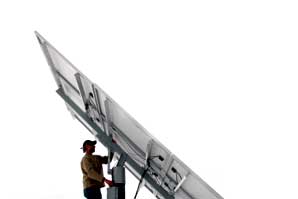KILA – In a valley with notoriously gray skies, solar-powered electricity might not seem to be the most viable energy source. Yet for decades, rural people who live outside of the Flathead Electric Cooperative power grid have relied on a combination of solar panels backed up by batteries or generators.
Now, tucked away in Kila, the Flathead has its first grid-tied, solar-powered business: Calm Animal Care. With the recently approved $787 billion federal stimulus package promising substantial funds and tax incentives for renewable energy, more could be on the way.
 |
|
Twinkie finds a comfortable seat near receptionist Julie Johnson, right, at the Calm Animal Care Veterinary Clinic in Kila. During power outages, the phone system and the main computer system will be powered by the grid-tied, battery-backup solar electricity system. |
Also, a group named Great Northern Solar recently launched a movement among local businesspeople to build a solar panel manufacturing plant in the Flathead.
Last November, Kip Drobish of Oso Renewable Energy along with Whitefish electrician Richard Cowen, installed a grid-tied, battery-backup photovoltaic system for Barbara Calm, the clinic’s owner. The term “grid-tied” means that Calm’s solar electricity system is connected directly to the Flathead Electric power grid. At the clinic, nine large solar panels harvest energy – sunlight – and either supply on-site electrical needs or feed energy back into the grid when the system’s output is greater than the on-site load demand.
Furthermore, energy is stored in a backup battery, which is the foremost reason Calm installed the system. The Kila area is known for frequent and, at times, prolonged power outages. Calm’s clinic has computerized medical records, one of the only digital X-ray processors in the valley and specialized dental lamps that are of utmost importance when working on an animal’s teeth. Surgeries can’t be interrupted either.
So not only is it dangerous for her veterinary practice to have sudden blackouts, it’s not good for business. As she puts it: “I’ve never lost a patient, but I’ve lost clients.” When the power goes out, her business can operate for up to two days on the battery.
 |
|
Dr. Barbara Calm talks about how being on a grid-tied, battery-backup solar electricity system can keep her veterinary clinic powered during outages. |
Drobish said Calm is part of what he views as an increasingly necessary – though lagging in Montana – movement away from fossil fuels and toward renewable energy, especially solar.
“She’s a pioneer,” Drobish said.
Solar power is nothing new. Humans have harnessed sunlight using a variety of methods since ancient times and, in the more modernly applicable form, photovoltaic systems have been relatively prominent since the 1970s. Energy derived from sunlight is considered to be clean and, furthermore, inexhaustible. The sun, aside from cloudy days, is always there.
In recent years, the valley has seen a steady rise in interest regarding renewable energy, but most of the solar-powered efforts remain off-grid, meaning they are not linked to Flathead Electric’s utilities. Ross Holter, energy services supervisor for Flathead Electric, said there are six local residences with grid-tied solar power systems, while Calm’s is the only business besides Flathead Electric itself. There is also an office building in Bigfork with solar panels, Holter said, as well as a residence that uses wind energy.
The Kila area is home to a community of off-grid, solar-powered homes that have backup generators. Holter said there are also people scattered throughout isolated places like the North Fork of the Flathead who utilize solar energy. Calm’s personal residence, which is off the grid, has relied on solar panels and a backup generator since the 1980s. Drobish installed a system at his Kila house in 1993.
But Drobish, Calm and Holter all point out that people shouldn’t consider switching to a renewable energy source if they haven’t taken the time to understand their current energy use. Only once people understand the importance of well-sealed windows and doors, efficient light bulbs, appropriate use of thermostat timers, and overall energy conservation are they prepared to adopt an alternative system.
For example, Drobish said his household, with three people, uses roughly one-tenth of the kilowatt hours of an average American home. If people install a solar-energy system and continue to consume more electricity than they produce, the value is offset.
“You really have no business switching to renewable energy until you’ve unplugged that beer fridge outside,” Holter said.
 |
|
Kip Drobish, with Oso Renewable Energy, realigns solar panels at Calm Animal Care Veterinary Clinic in Kila. |
Solar energy in Montana, proponents remind, shouldn’t be viewed as a way to save money. In fact, it can be fairly pricey. Calm spent more than $20,000 to install her system and, in a state with significantly lower electricity rates than places such as California, the cost-cutting incentive is minimized. But Drobish points out: “Solar power has a guaranteed payback – you will always harvest sun.”
Some states, like California and Arizona, already have extensive solar-powered electricity networks for both commercial and residential uses. In late February San Francisco-based Pacific Gas and Electric announced plans to spend $1.5 billion of ratepayers’ money on a large photovoltaic project that is expected to generate enough electricity to supply 150,000 homes when completed. Earlier in the month, a giant solar energy contract was worked out in California that officials hope will power 845,000 homes with the sun’s energy.
But multiple factors make those locations more suitable for solar power. The main three are: higher electricity rates that encourage alternative energy sources, better tax incentives and, of course, more sun hours.
The federal government provides a tax credit worth up to 30 percent of the total upfront cost of installing a solar-energy system. States have their own additional incentives. In Montana, people who install a non-fossil form of energy generation or heating are eligible for up to a $500 income tax credit.
Drobish said as more people adopt renewable energy systems, he believes the economic viability of solar power will increase. However, he said many utility companies in Montana aren’t receptive to the idea of alternative energy sources. But Flathead Electric is, which he says is an advantage for area residents hoping to make the switch. Holter said officials at Flathead Electric recognize that great changes in the energy world are on their way.
“Our board sees this as something that’s coming down in the future, so we’re trying to get ahead of the game,” Holter said.